Event Tourism's Impact: A Comprehensive Analysis Report
VerifiedAdded on 2021/04/21
|7
|1701
|72
Report
AI Summary
This report delves into the multifaceted impacts of event tourism on economies, cultures, and the environment. It begins by defining event tourism and its historical context, highlighting its evolution from ancient times to the modern era. The report then analyzes the economic benefits, such as increased GDP, job creation, and revenue for the hospitality sector. It differentiates between various event types, including mega, hallmark, major, and community events, and examines their unique characteristics and impacts. Furthermore, the report explores the cultural implications of event tourism, including cultural exchange and the promotion of local talent. Finally, it addresses the environmental consequences, such as increased pollution and deforestation, while also acknowledging efforts to mitigate these effects through infrastructure improvements and sustainable practices. The report concludes by summarizing the overall significance of event tourism as a major factor in destination marketing.
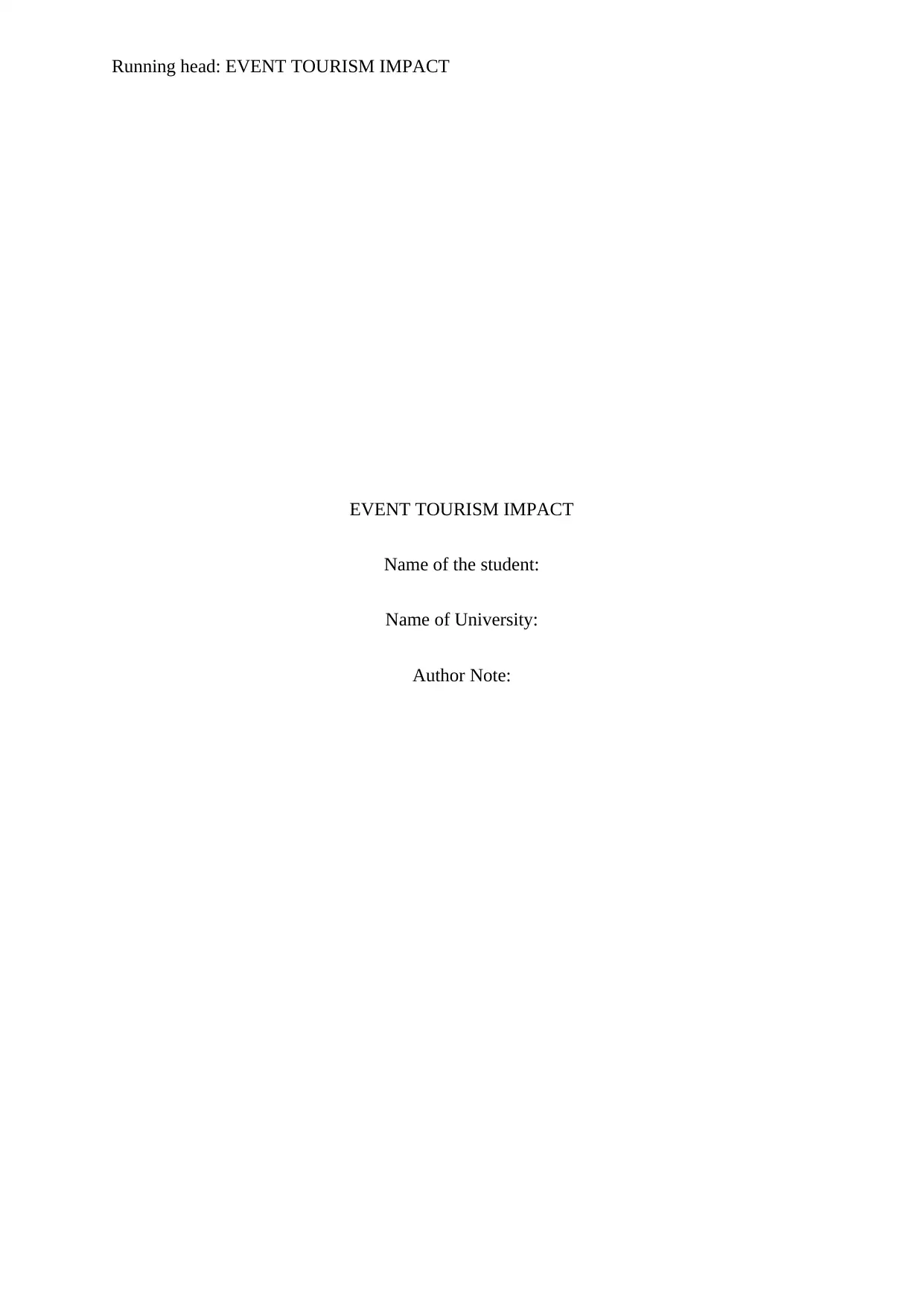
Running head: EVENT TOURISM IMPACT
EVENT TOURISM IMPACT
Name of the student:
Name of University:
Author Note:
EVENT TOURISM IMPACT
Name of the student:
Name of University:
Author Note:
Paraphrase This Document
Need a fresh take? Get an instant paraphrase of this document with our AI Paraphraser
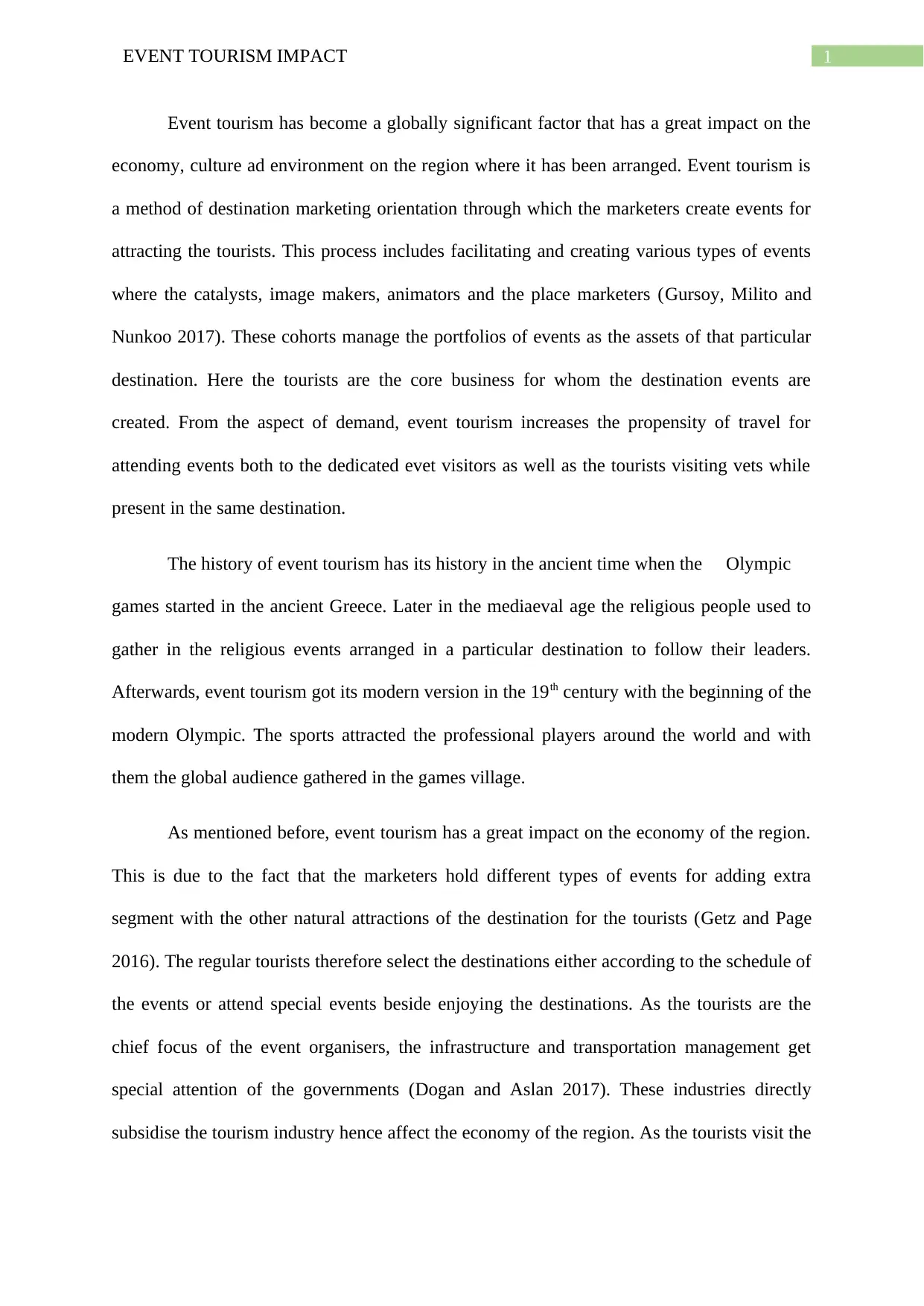
1EVENT TOURISM IMPACT
Event tourism has become a globally significant factor that has a great impact on the
economy, culture ad environment on the region where it has been arranged. Event tourism is
a method of destination marketing orientation through which the marketers create events for
attracting the tourists. This process includes facilitating and creating various types of events
where the catalysts, image makers, animators and the place marketers (Gursoy, Milito and
Nunkoo 2017). These cohorts manage the portfolios of events as the assets of that particular
destination. Here the tourists are the core business for whom the destination events are
created. From the aspect of demand, event tourism increases the propensity of travel for
attending events both to the dedicated evet visitors as well as the tourists visiting vets while
present in the same destination.
The history of event tourism has its history in the ancient time when the Olympic
games started in the ancient Greece. Later in the mediaeval age the religious people used to
gather in the religious events arranged in a particular destination to follow their leaders.
Afterwards, event tourism got its modern version in the 19th century with the beginning of the
modern Olympic. The sports attracted the professional players around the world and with
them the global audience gathered in the games village.
As mentioned before, event tourism has a great impact on the economy of the region.
This is due to the fact that the marketers hold different types of events for adding extra
segment with the other natural attractions of the destination for the tourists (Getz and Page
2016). The regular tourists therefore select the destinations either according to the schedule of
the events or attend special events beside enjoying the destinations. As the tourists are the
chief focus of the event organisers, the infrastructure and transportation management get
special attention of the governments (Dogan and Aslan 2017). These industries directly
subsidise the tourism industry hence affect the economy of the region. As the tourists visit the
Event tourism has become a globally significant factor that has a great impact on the
economy, culture ad environment on the region where it has been arranged. Event tourism is
a method of destination marketing orientation through which the marketers create events for
attracting the tourists. This process includes facilitating and creating various types of events
where the catalysts, image makers, animators and the place marketers (Gursoy, Milito and
Nunkoo 2017). These cohorts manage the portfolios of events as the assets of that particular
destination. Here the tourists are the core business for whom the destination events are
created. From the aspect of demand, event tourism increases the propensity of travel for
attending events both to the dedicated evet visitors as well as the tourists visiting vets while
present in the same destination.
The history of event tourism has its history in the ancient time when the Olympic
games started in the ancient Greece. Later in the mediaeval age the religious people used to
gather in the religious events arranged in a particular destination to follow their leaders.
Afterwards, event tourism got its modern version in the 19th century with the beginning of the
modern Olympic. The sports attracted the professional players around the world and with
them the global audience gathered in the games village.
As mentioned before, event tourism has a great impact on the economy of the region.
This is due to the fact that the marketers hold different types of events for adding extra
segment with the other natural attractions of the destination for the tourists (Getz and Page
2016). The regular tourists therefore select the destinations either according to the schedule of
the events or attend special events beside enjoying the destinations. As the tourists are the
chief focus of the event organisers, the infrastructure and transportation management get
special attention of the governments (Dogan and Aslan 2017). These industries directly
subsidise the tourism industry hence affect the economy of the region. As the tourists visit the
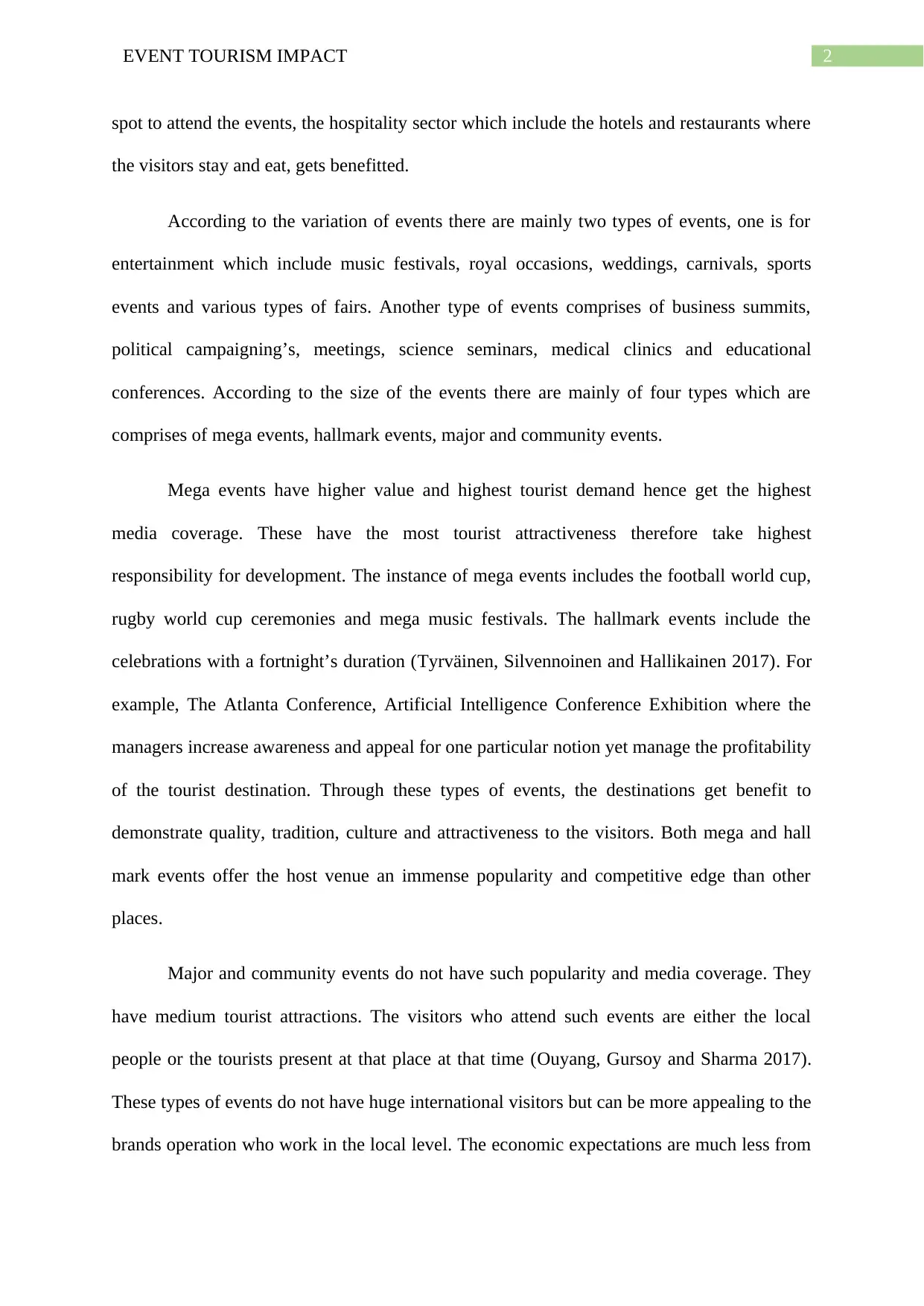
2EVENT TOURISM IMPACT
spot to attend the events, the hospitality sector which include the hotels and restaurants where
the visitors stay and eat, gets benefitted.
According to the variation of events there are mainly two types of events, one is for
entertainment which include music festivals, royal occasions, weddings, carnivals, sports
events and various types of fairs. Another type of events comprises of business summits,
political campaigning’s, meetings, science seminars, medical clinics and educational
conferences. According to the size of the events there are mainly of four types which are
comprises of mega events, hallmark events, major and community events.
Mega events have higher value and highest tourist demand hence get the highest
media coverage. These have the most tourist attractiveness therefore take highest
responsibility for development. The instance of mega events includes the football world cup,
rugby world cup ceremonies and mega music festivals. The hallmark events include the
celebrations with a fortnight’s duration (Tyrväinen, Silvennoinen and Hallikainen 2017). For
example, The Atlanta Conference, Artificial Intelligence Conference Exhibition where the
managers increase awareness and appeal for one particular notion yet manage the profitability
of the tourist destination. Through these types of events, the destinations get benefit to
demonstrate quality, tradition, culture and attractiveness to the visitors. Both mega and hall
mark events offer the host venue an immense popularity and competitive edge than other
places.
Major and community events do not have such popularity and media coverage. They
have medium tourist attractions. The visitors who attend such events are either the local
people or the tourists present at that place at that time (Ouyang, Gursoy and Sharma 2017).
These types of events do not have huge international visitors but can be more appealing to the
brands operation who work in the local level. The economic expectations are much less from
spot to attend the events, the hospitality sector which include the hotels and restaurants where
the visitors stay and eat, gets benefitted.
According to the variation of events there are mainly two types of events, one is for
entertainment which include music festivals, royal occasions, weddings, carnivals, sports
events and various types of fairs. Another type of events comprises of business summits,
political campaigning’s, meetings, science seminars, medical clinics and educational
conferences. According to the size of the events there are mainly of four types which are
comprises of mega events, hallmark events, major and community events.
Mega events have higher value and highest tourist demand hence get the highest
media coverage. These have the most tourist attractiveness therefore take highest
responsibility for development. The instance of mega events includes the football world cup,
rugby world cup ceremonies and mega music festivals. The hallmark events include the
celebrations with a fortnight’s duration (Tyrväinen, Silvennoinen and Hallikainen 2017). For
example, The Atlanta Conference, Artificial Intelligence Conference Exhibition where the
managers increase awareness and appeal for one particular notion yet manage the profitability
of the tourist destination. Through these types of events, the destinations get benefit to
demonstrate quality, tradition, culture and attractiveness to the visitors. Both mega and hall
mark events offer the host venue an immense popularity and competitive edge than other
places.
Major and community events do not have such popularity and media coverage. They
have medium tourist attractions. The visitors who attend such events are either the local
people or the tourists present at that place at that time (Ouyang, Gursoy and Sharma 2017).
These types of events do not have huge international visitors but can be more appealing to the
brands operation who work in the local level. The economic expectations are much less from
⊘ This is a preview!⊘
Do you want full access?
Subscribe today to unlock all pages.

Trusted by 1+ million students worldwide
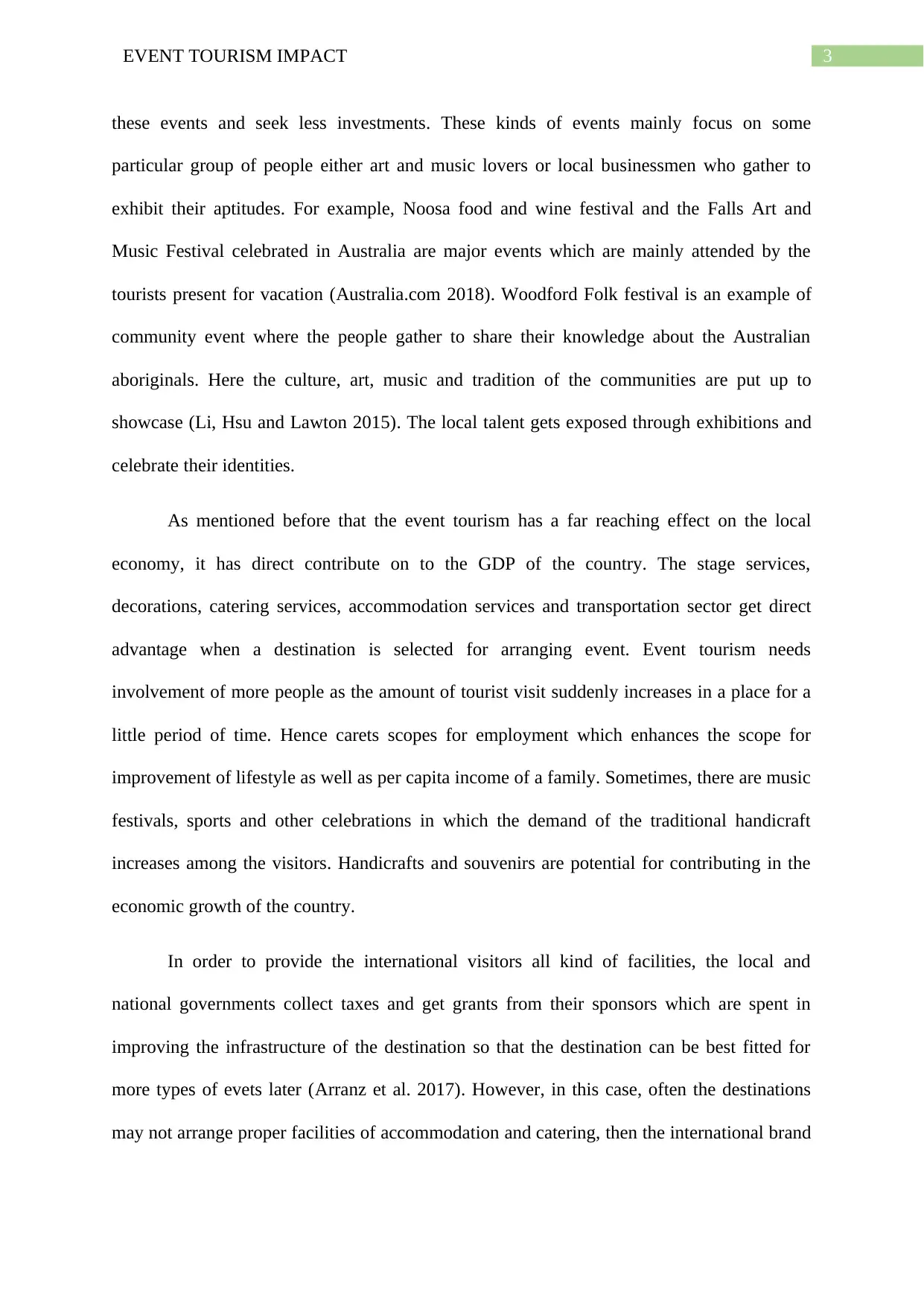
3EVENT TOURISM IMPACT
these events and seek less investments. These kinds of events mainly focus on some
particular group of people either art and music lovers or local businessmen who gather to
exhibit their aptitudes. For example, Noosa food and wine festival and the Falls Art and
Music Festival celebrated in Australia are major events which are mainly attended by the
tourists present for vacation (Australia.com 2018). Woodford Folk festival is an example of
community event where the people gather to share their knowledge about the Australian
aboriginals. Here the culture, art, music and tradition of the communities are put up to
showcase (Li, Hsu and Lawton 2015). The local talent gets exposed through exhibitions and
celebrate their identities.
As mentioned before that the event tourism has a far reaching effect on the local
economy, it has direct contribute on to the GDP of the country. The stage services,
decorations, catering services, accommodation services and transportation sector get direct
advantage when a destination is selected for arranging event. Event tourism needs
involvement of more people as the amount of tourist visit suddenly increases in a place for a
little period of time. Hence carets scopes for employment which enhances the scope for
improvement of lifestyle as well as per capita income of a family. Sometimes, there are music
festivals, sports and other celebrations in which the demand of the traditional handicraft
increases among the visitors. Handicrafts and souvenirs are potential for contributing in the
economic growth of the country.
In order to provide the international visitors all kind of facilities, the local and
national governments collect taxes and get grants from their sponsors which are spent in
improving the infrastructure of the destination so that the destination can be best fitted for
more types of evets later (Arranz et al. 2017). However, in this case, often the destinations
may not arrange proper facilities of accommodation and catering, then the international brand
these events and seek less investments. These kinds of events mainly focus on some
particular group of people either art and music lovers or local businessmen who gather to
exhibit their aptitudes. For example, Noosa food and wine festival and the Falls Art and
Music Festival celebrated in Australia are major events which are mainly attended by the
tourists present for vacation (Australia.com 2018). Woodford Folk festival is an example of
community event where the people gather to share their knowledge about the Australian
aboriginals. Here the culture, art, music and tradition of the communities are put up to
showcase (Li, Hsu and Lawton 2015). The local talent gets exposed through exhibitions and
celebrate their identities.
As mentioned before that the event tourism has a far reaching effect on the local
economy, it has direct contribute on to the GDP of the country. The stage services,
decorations, catering services, accommodation services and transportation sector get direct
advantage when a destination is selected for arranging event. Event tourism needs
involvement of more people as the amount of tourist visit suddenly increases in a place for a
little period of time. Hence carets scopes for employment which enhances the scope for
improvement of lifestyle as well as per capita income of a family. Sometimes, there are music
festivals, sports and other celebrations in which the demand of the traditional handicraft
increases among the visitors. Handicrafts and souvenirs are potential for contributing in the
economic growth of the country.
In order to provide the international visitors all kind of facilities, the local and
national governments collect taxes and get grants from their sponsors which are spent in
improving the infrastructure of the destination so that the destination can be best fitted for
more types of evets later (Arranz et al. 2017). However, in this case, often the destinations
may not arrange proper facilities of accommodation and catering, then the international brand
Paraphrase This Document
Need a fresh take? Get an instant paraphrase of this document with our AI Paraphraser
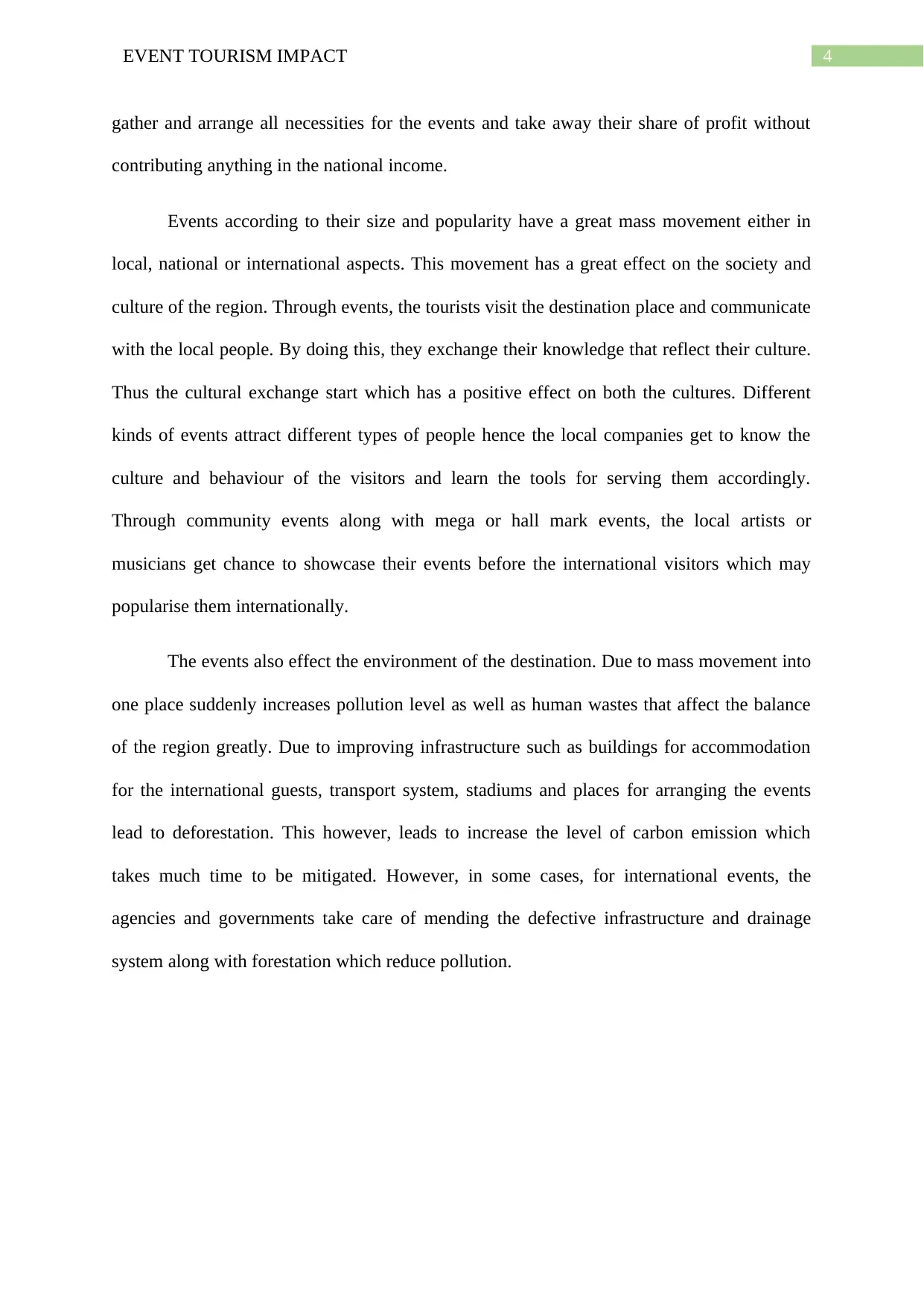
4EVENT TOURISM IMPACT
gather and arrange all necessities for the events and take away their share of profit without
contributing anything in the national income.
Events according to their size and popularity have a great mass movement either in
local, national or international aspects. This movement has a great effect on the society and
culture of the region. Through events, the tourists visit the destination place and communicate
with the local people. By doing this, they exchange their knowledge that reflect their culture.
Thus the cultural exchange start which has a positive effect on both the cultures. Different
kinds of events attract different types of people hence the local companies get to know the
culture and behaviour of the visitors and learn the tools for serving them accordingly.
Through community events along with mega or hall mark events, the local artists or
musicians get chance to showcase their events before the international visitors which may
popularise them internationally.
The events also effect the environment of the destination. Due to mass movement into
one place suddenly increases pollution level as well as human wastes that affect the balance
of the region greatly. Due to improving infrastructure such as buildings for accommodation
for the international guests, transport system, stadiums and places for arranging the events
lead to deforestation. This however, leads to increase the level of carbon emission which
takes much time to be mitigated. However, in some cases, for international events, the
agencies and governments take care of mending the defective infrastructure and drainage
system along with forestation which reduce pollution.
gather and arrange all necessities for the events and take away their share of profit without
contributing anything in the national income.
Events according to their size and popularity have a great mass movement either in
local, national or international aspects. This movement has a great effect on the society and
culture of the region. Through events, the tourists visit the destination place and communicate
with the local people. By doing this, they exchange their knowledge that reflect their culture.
Thus the cultural exchange start which has a positive effect on both the cultures. Different
kinds of events attract different types of people hence the local companies get to know the
culture and behaviour of the visitors and learn the tools for serving them accordingly.
Through community events along with mega or hall mark events, the local artists or
musicians get chance to showcase their events before the international visitors which may
popularise them internationally.
The events also effect the environment of the destination. Due to mass movement into
one place suddenly increases pollution level as well as human wastes that affect the balance
of the region greatly. Due to improving infrastructure such as buildings for accommodation
for the international guests, transport system, stadiums and places for arranging the events
lead to deforestation. This however, leads to increase the level of carbon emission which
takes much time to be mitigated. However, in some cases, for international events, the
agencies and governments take care of mending the defective infrastructure and drainage
system along with forestation which reduce pollution.
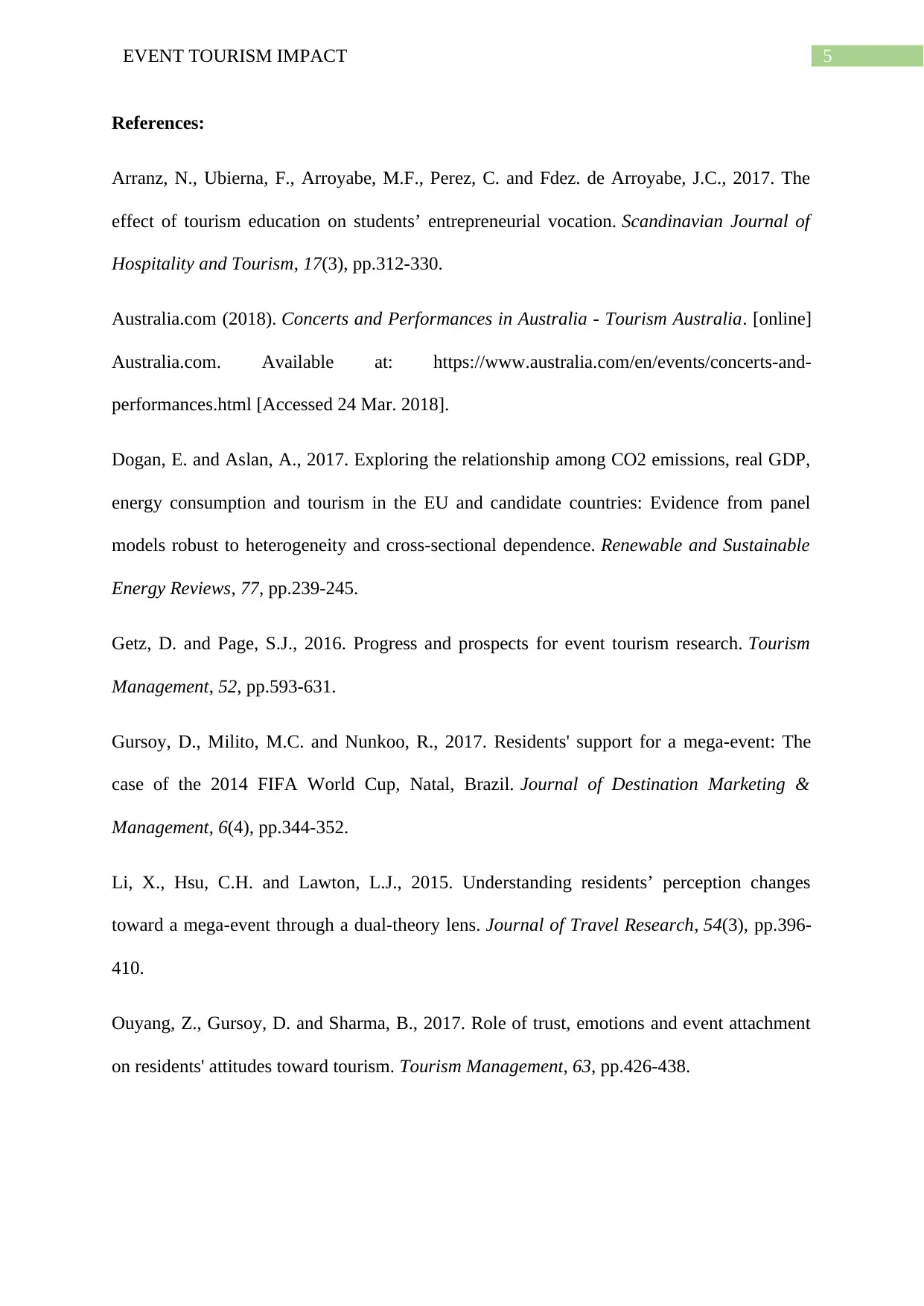
5EVENT TOURISM IMPACT
References:
Arranz, N., Ubierna, F., Arroyabe, M.F., Perez, C. and Fdez. de Arroyabe, J.C., 2017. The
effect of tourism education on students’ entrepreneurial vocation. Scandinavian Journal of
Hospitality and Tourism, 17(3), pp.312-330.
Australia.com (2018). Concerts and Performances in Australia - Tourism Australia. [online]
Australia.com. Available at: https://www.australia.com/en/events/concerts-and-
performances.html [Accessed 24 Mar. 2018].
Dogan, E. and Aslan, A., 2017. Exploring the relationship among CO2 emissions, real GDP,
energy consumption and tourism in the EU and candidate countries: Evidence from panel
models robust to heterogeneity and cross-sectional dependence. Renewable and Sustainable
Energy Reviews, 77, pp.239-245.
Getz, D. and Page, S.J., 2016. Progress and prospects for event tourism research. Tourism
Management, 52, pp.593-631.
Gursoy, D., Milito, M.C. and Nunkoo, R., 2017. Residents' support for a mega-event: The
case of the 2014 FIFA World Cup, Natal, Brazil. Journal of Destination Marketing &
Management, 6(4), pp.344-352.
Li, X., Hsu, C.H. and Lawton, L.J., 2015. Understanding residents’ perception changes
toward a mega-event through a dual-theory lens. Journal of Travel Research, 54(3), pp.396-
410.
Ouyang, Z., Gursoy, D. and Sharma, B., 2017. Role of trust, emotions and event attachment
on residents' attitudes toward tourism. Tourism Management, 63, pp.426-438.
References:
Arranz, N., Ubierna, F., Arroyabe, M.F., Perez, C. and Fdez. de Arroyabe, J.C., 2017. The
effect of tourism education on students’ entrepreneurial vocation. Scandinavian Journal of
Hospitality and Tourism, 17(3), pp.312-330.
Australia.com (2018). Concerts and Performances in Australia - Tourism Australia. [online]
Australia.com. Available at: https://www.australia.com/en/events/concerts-and-
performances.html [Accessed 24 Mar. 2018].
Dogan, E. and Aslan, A., 2017. Exploring the relationship among CO2 emissions, real GDP,
energy consumption and tourism in the EU and candidate countries: Evidence from panel
models robust to heterogeneity and cross-sectional dependence. Renewable and Sustainable
Energy Reviews, 77, pp.239-245.
Getz, D. and Page, S.J., 2016. Progress and prospects for event tourism research. Tourism
Management, 52, pp.593-631.
Gursoy, D., Milito, M.C. and Nunkoo, R., 2017. Residents' support for a mega-event: The
case of the 2014 FIFA World Cup, Natal, Brazil. Journal of Destination Marketing &
Management, 6(4), pp.344-352.
Li, X., Hsu, C.H. and Lawton, L.J., 2015. Understanding residents’ perception changes
toward a mega-event through a dual-theory lens. Journal of Travel Research, 54(3), pp.396-
410.
Ouyang, Z., Gursoy, D. and Sharma, B., 2017. Role of trust, emotions and event attachment
on residents' attitudes toward tourism. Tourism Management, 63, pp.426-438.
⊘ This is a preview!⊘
Do you want full access?
Subscribe today to unlock all pages.

Trusted by 1+ million students worldwide

6EVENT TOURISM IMPACT
Tyrväinen, L., Silvennoinen, H. and Hallikainen, V., 2017. Effect of the season and forest
management on the visual quality of the nature-based tourism environment: a case from
Finnish Lapland. Scandinavian Journal of Forest Research, 32(4), pp.349-359.
Tyrväinen, L., Silvennoinen, H. and Hallikainen, V., 2017. Effect of the season and forest
management on the visual quality of the nature-based tourism environment: a case from
Finnish Lapland. Scandinavian Journal of Forest Research, 32(4), pp.349-359.
1 out of 7
Related Documents
Your All-in-One AI-Powered Toolkit for Academic Success.
+13062052269
info@desklib.com
Available 24*7 on WhatsApp / Email
![[object Object]](/_next/static/media/star-bottom.7253800d.svg)
Unlock your academic potential
Copyright © 2020–2025 A2Z Services. All Rights Reserved. Developed and managed by ZUCOL.




